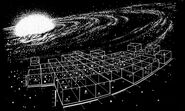mNo edit summary |
|||
| (27 intermediate revisions by 6 users not shown) | |||
| Line 1: | Line 1: | ||
| + | Consisting of a [[star|primary]] and four planets, the '''Romulan system''' was an inhabited [[star system]] in [[Sector Z-6]]. Its [[second planets|second]] and [[third planets|third]] [[planet]]s were [[Romulus]] and [[Remus]], the [[homeworld]]s of the [[Romulan]]s and [[Reman]]s, respectively. ({{TOS|Balance of Terror}}, ''display graphic''; {{film|6}}, ''production art''; {{DS9|The Search, Part II}}; {{film|10}}) |
||
| + | During the [[Neutral Zone Incursion]] of [[2266]], the location of the Romulan system was labeled on a map of Sector Z-6 that was displayed on the [[bridge]] [[viewscreen]] of the {{USS|Enterprise|NCC-1701}}. ({{TOS|Balance of Terror}}, ''production art'') |
||
| − | The '''Romulan system''' was a [[planet]]ary [[star system|system]]. This system consisted of a [[star|primary]] and four planets. Two of the planets were [[inhabited planets|inhabited]]. One of these planets, [[Romulus]], was the capital of the [[Romulan Star Empire]]. The system was located in [[Sector Z-6]], a region of space in the [[Alpha Quadrant]]. ({{TOS|Balance of Terror}}; {{film|10}}) The location of Romulus and Remus in the [[Milky Way Galaxy]] was depicted on a [[Federation]] [[star chart]], in [[2293]]. ({{film|6}}) In [[2387]], this system was devastated by the [[Supernova of 2387]]. At least one planet, Romulus, was destroyed. ({{film|11}}) |
||
| + | In [[2293]], the location of Romulus and Remus in the [[Milky Way Galaxy]] was labeled in a [[star chart]] that was in [[Captain]] [[James T. Kirk]]'s [[quarters]] aboard the {{USS|Enterprise|NCC-1701-A|-A}}. ({{film|6}}, ''[[okudagram]]'') |
||
| − | ==See also== |
||
| + | |||
| ⚫ | |||
| + | In [[2387]], this system was devastated by the [[Supernova of 2387]], completely destroying Romulus. ({{film|11}}) |
||
<gallery> |
<gallery> |
||
| − | File: |
+ | File:The Explored Galaxy.jpg|The location of Romulus and Remus in "The Explored Galaxy" star chart |
File: Romulan Neutral Zone map.jpg|Star Sector Z-6: The location of Romulus |
File: Romulan Neutral Zone map.jpg|Star Sector Z-6: The location of Romulus |
||
File:Romulan system map.jpg|A map of the Romulan star system, featuring [[Romulus]] and [[Remus]], ''not to scale'' |
File:Romulan system map.jpg|A map of the Romulan star system, featuring [[Romulus]] and [[Remus]], ''not to scale'' |
||
</gallery> |
</gallery> |
||
| − | == |
+ | ==See also== |
| ⚫ | |||
| − | On a [[computer]] display in {{film|10}}, the Romulan system was depicted, containing one primary star and four [[orbit]]ing planets, among them Romulus and Remus. However, since we do not know anything about the other two planets or the Romulan [[sun]], there is no speculative information about those celestial bodies included in this article. The designation for the Romulan sun was unknown, although some unverified sources suggest it might be "Romulus", too. However, in Diane Duane's "Rihannsu" novels, the Romulan sun was referred to as Eisn. |
||
| − | |||
| − | ===''The Explored Galaxy''=== |
||
| − | This chart was also seen in several ''[[Star Trek: The Next Generation]]'' and ''[[Star Trek: Deep Space Nine]]'' episodes set in the [[24th century]], from the year [[2364]] to [[2370]]. These were: {{TNG|Conspiracy|The Measure Of A Man|The Emissary|The Mind's Eye|The Game}} and {{DS9|In the Hands of the Prophets|Cardassians}}. |
||
| + | ==Background information== |
||
| − | ===''[[Star Trek: Star Charts]]''=== |
||
| + | According to {{st.com|romulus|Startrek.com}}, the primary star in the system was called Romulus. According to ''[[Star Trek Maps]]'' (page 29) and ''[[The Worlds of the Federation]]'' (page 148), the Romulan star system was a [[binary star system]] of two white dwarfs known by the Federation as Romulus (primary) and Romulus B (secondary). In Diane Duane's ''[[Rihannsu]]'' novels, the indigenous name for the Romulan sun was Eisn. |
||
| − | The Romulus system was a [[binary star system]]. '''Romulus A''' was a [[Star Trek: Star Charts#Spectral classification|Class M]] star with a magnitude of +3, which was ten times brighter than [[Sol]]. '''Romulus B''' was a [[Star Trek: Star Charts#Spectral classification|Class K star]] This system was in the Romulan War Theater of Operations (2156-60). (''[[Star Trek: Star Charts]]'', pg. 66) |
||
| + | According to the ''[[Star Trek: Star Charts]]'' (pg. 66), this system was located in or near the Romulan War Theater of Operations (2156-2160). |
||
[[de:Romulanisches System]] |
[[de:Romulanisches System]] |
||
[[fr:Système romulien]] |
[[fr:Système romulien]] |
||
Revision as of 00:49, 16 August 2014
Consisting of a primary and four planets, the Romulan system was an inhabited star system in Sector Z-6. Its second and third planets were Romulus and Remus, the homeworlds of the Romulans and Remans, respectively. (TOS: "Balance of Terror", display graphic; Star Trek VI: The Undiscovered Country, production art; DS9: "The Search, Part II"; Star Trek Nemesis)
During the Neutral Zone Incursion of 2266, the location of the Romulan system was labeled on a map of Sector Z-6 that was displayed on the bridge viewscreen of the USS Enterprise. (TOS: "Balance of Terror", production art)
In 2293, the location of Romulus and Remus in the Milky Way Galaxy was labeled in a star chart that was in Captain James T. Kirk's quarters aboard the USS Enterprise-A. (Star Trek VI: The Undiscovered Country, okudagram)
In 2387, this system was devastated by the Supernova of 2387, completely destroying Romulus. (Star Trek)
See also
Background information
According to Startrek.com, the primary star in the system was called Romulus. According to Star Trek Maps (page 29) and The Worlds of the Federation (page 148), the Romulan star system was a binary star system of two white dwarfs known by the Federation as Romulus (primary) and Romulus B (secondary). In Diane Duane's Rihannsu novels, the indigenous name for the Romulan sun was Eisn.
According to the Star Trek: Star Charts (pg. 66), this system was located in or near the Romulan War Theater of Operations (2156-2160).


